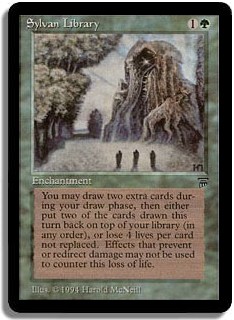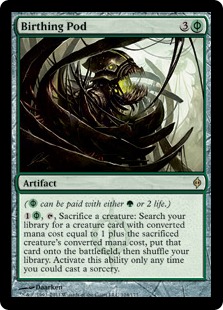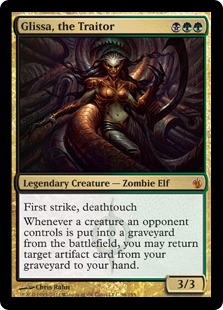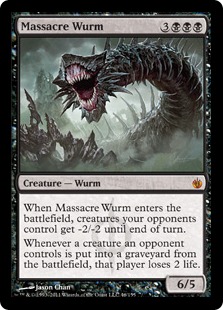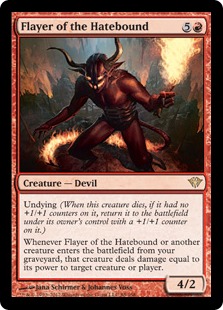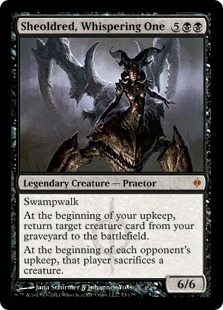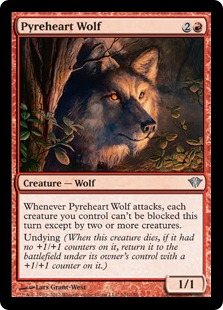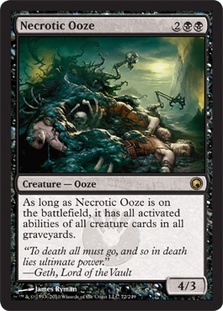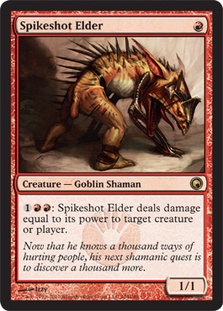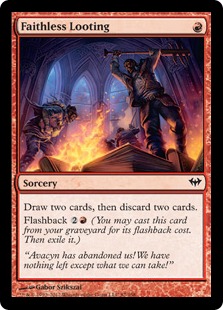First off, I want to give a big shout-out to my Richmond crew who went up to the StarCityGames.com Open Series: Baltimore featuring the Invitational this weekend and kicked major tail. Joshua Adams scored a Top 4 in the Legacy Open and a respectable 91st in the Standard Open. Andrew Indelicato got 14th in the Standard Open and 25th in the Legacy Open. Eric D. Brown made 10th in the Legacy Open. And it was also great to see Good Man Kenny Mayer chalk up another Top 8 in the Standard Open! It was great to see so many friends have great performances over the weekend.
One thing that kinda blew me away as I was pouring over the coverage and rooting for Joshua to win the Legacy Open through Facebook and texts, especially when it became clear that as the Sneak and Show deck versus three Maverick decks in the Top 4 he was the proverbial fox in the henhouse. I was combing through the Maverick decklists, looking for any possible way these decks could beat Josh (and outside of Josh’s admitted mulligan mistake and ridiculous draws by Todd Anderson, there was really no way they could), and I realized something…
Maverick is totally a Bennie deck!
Knight of the Reliquary, Noble Hierarch, Qasali Pridemage, Scryb Ranger, Green Sun’s Zenith, Scavenging Ooze, Sylvan Library, Gaea’s Cradle…even the Mother of Runes is right up my alley! And then Adam Cai took it further into Bennieland by adding Fauna Shaman? I’d spent so much time being incredibly unenthusiastic over Legacy—years now—that it just feels surreal that there’s a deck right up my alley, a deck that plays right into my strengths and preferences, and it’s actually good in Legacy. Pinch me.
Of course with my luck by the time that I get around to being able to play in a Legacy tournament (maybe Washington, DC on August 5th), the metagame will have turned completely hostile to the deck or something will get banned to make it a total dog. But for now it’s rather exciting to know that I have a go-to deck in Legacy if I need one!
Right now, though, I want to talk about Standard!
It looks like I’ll be able to play FNM this week, and I’ve been itching to play Standard lately. Not that the Standard meta looks all that interesting right now with all the Delver nonsense, but I’ve really wanted to give my Glissa Pod deck another run. I really wish I’d been able to get some practice games in with that deck and not had to drop after seven rounds of Swiss (5-2) at the Richmond Open a month or so back, because I’m pretty sure I would’ve made Top 16 with the deck and maybe even made Top 8. The deck’s concept is solid…and seems to have been vindicated by the recent success of more aggressive Pod lists lately.
Max Tietze won the Invitational last weekend with Naya Birthing Pod:
Creatures (28)
- 1 Solemn Simulacrum
- 4 Birds of Paradise
- 1 Archon of Justice
- 1 Acidic Slime
- 1 Inferno Titan
- 1 Sun Titan
- 1 Wurmcoil Engine
- 1 Viridian Emissary
- 1 Elesh Norn, Grand Cenobite
- 1 Phyrexian Metamorph
- 3 Blade Splicer
- 1 Fiend Hunter
- 2 Avacyn's Pilgrim
- 1 Geist-Honored Monk
- 1 Daybreak Ranger
- 3 Strangleroot Geist
- 4 Huntmaster of the Fells
Lands (24)
Spells (8)

Brian Kibler also did well with Naya Birthing Pod, scoring a 10th place finish. Over in the Standard Open, David Doberne got 6th place with his build, basically Naya splashing a little bit of blue for Phantasmal Images and a Trinket Mage in the sideboard.
“When you don’t have a Birthing Pod, the deck now has a real plan: attack.” — Ari Lax
Ari Lax dug into the “recent” discovery of a better way to build Birthing Pod this week in his column. If you have Premium and haven’t already, you should check it out. Of course, if you’ve been following my column and my adventures with Glissa Pod in particular, this revelation should come as no surprise! I’ve been noodling around with Birthing Pod for a long time, and it’s been painfully obvious that the initial decks were just way too fragile without its namesake artifact.
The undying creatures from Dark Ascension really allowed a new approach to unfold by being aggressive enough to attack when that line of play is appropriate, while also being resilient enough to defend when you’re on the Birthing Pod plan…while also being great Pod food whether you’re being aggressive or defensive. Young Wolf into Strangleroot Geist into Glissa, the Traitor is a curve capable of either excellent beatdown or excellent defense with or without Birthing Pod.
Personally, I think my approach to Birthing Pod has some advantages over the Naya plan, namely because of Glissa, the Traitor. Glissa fits perfectly into the idea of being both a great aggressive and a great defensive creature, while adding a powerful card advantage element to the mix that can win games on its own while also backing up Birthing Pod. Let’s face it, even the most aggressive Birthing Pod deck still works best with Birthing Pod online, so Birthing Pod is going to draw responses from your opponents. Glissa helps you continue that line of attack at the small cost of killing opposing creatures (something you generally want to be doing anyway).
Now I know I’ve beaten the Glissa Pod drum quite a bit over the past couple months (most recently here), so I’ll ease up on the reasoning and present my latest build for those who are interested. I’m then going to present one other Birthing Pod deck I’ve been cooking up that takes a similar approach of having a strong Plan B when you don’t have Birthing Pod. This isn’t another Naya Pod deck—you can get plenty of that color configuration over on the Premium side.
Creatures (25)
- 1 Solemn Simulacrum
- 1 Trinket Mage
- 1 Acidic Slime
- 1 Wurmcoil Engine
- 2 Sylvok Replica
- 1 Molten-Tail Masticore
- 1 Perilous Myr
- 3 Glissa, the Traitor
- 1 Massacre Wurm
- 1 Viridian Emissary
- 1 Hex Parasite
- 2 Phyrexian Metamorph
- 1 Bloodline Keeper
- 4 Strangleroot Geist
- 1 Vorapede
- 3 Young Wolf
Lands (24)
Spells (11)

I’ve decided to go back to just a small splash of blue for Trinket Mage to more reliably have access to Nihil Spellbomb maindeck without dedicating more than one slot to it. Trinket Mage for Hex Parasite is a fine plan when you’ve got a couple undying creatures on the board, and Nihil Spellbomb can even turn into a recurring cantrip whether or not your opponent is utilizing his graveyard. However, I think having that Spellbomb main and recurrable with Glissa gives you access to a potent weapon against the Zombies decks as well as Frites.
Also in a nod to the Zombie menace is the move of Go for the Throat main and moving the Ratchet Bombs to the sideboard. I’ve been very happy to have a fair number of answers to Obliterator that don’t involve damage.
The rest of the maindeck remains much the same since the same general endgame remains quite potent:Â Pod into Vorapede and then Pod Vorapede into Massacre Wurm. You honestly don’t want to Pod away Massacre Wurm into a seven since it continues to apply pressure even after its enters-the-battlefield trigger; if you need to keep Podding, dig up Metamorphs and copy the Wurm.
I tweaked the sideboard some outside of moving the Ratchet Bombs to the side (still good against weenie decks and tokens). More Spellbombs to force the Zombies decks to fight fair, a Spellskite to keep Wolf Run decks honest, a Precursor Golem as another colorless answer to Mirran Crusader…and I still like Bitterheart Witch into Curse of Death’s Hold.
New Deck Alert! (kinda)
A few weeks back, I got an email from James Fernandez sharing with me a Jund Pod deck. He used some Glissa Pod stuff as well as some Naya Pod stuff, topping off the curve with Mikaeus, the Unhallowed and Hatebound Flayer. It looked like a lot of fun, but what really caught my eye was Flayer of the Hatebound.
For a while as I worked on GlissaPod, I had Sheoldred, Whispering One as a seven to ramp up to with the idea that you could Pod Vorapede into Wurmcoil Engine then Pod Wurmcoil Engine into Sheoldred, leaving behind two 3/3 Wurm tokens and setting up recursion of the Wurmcoil Engine next turn. What I found, though, was that playing the deck I never wanted this line of play—I always wanted to Pod into Massacre Wurm and then keep Massacre Wurm around. Massacre Wurm very quickly ended the game unless your opponent had a way to kill it (say, Go for the Throat).
And therein is the problem. Either your six (Massacre Wurm) killed your opponent, or they killed your six and left you with no way to Pod into your seven. Eventually I cut Sheoldred altogether.
But Flayer of the Hatebound…that was a six with undying! And not only did it have undying, but it combined perfectly with what you wanted to do with Sheoldred—bring creatures back into play from the graveyard!
Part of why Vorapede was so great in Glissa Pod was because it was a resilient five that you could usually count on sticking around long enough to untap and Pod it into your six. Now I had a six that offered that same resilience while also having an ability that played nice with other undying creatures and Sheoldred.
Combing through what red offered us, I ran across Pyreheart Wolf. Now on the surface this looks like a “bad” card—Gray Ogre need sweet abilities to see play, and this is even smaller, a 1/1 for three. And yet…his attack trigger actually presents some decent synergy with a deck that can strike an aggressive pose. Plus, having a resilient three you can reliably Pod into your four is a pretty sweet thing to have available. Here’s one possible line of play: Pod Pyreheart Wolf into Phyrexian Metamorph copying Birthing Pod, which can tap to Pod the Wolf into Thrun, the Last Troll. This leaves you with two Pods and a creature quite likely to stick around long enough to untap next turn and cash into a 6/5 Vorapede and a Flayer of the Hatebound.
A quick word about Podding Vorapede into Flayer of the Hatebound. At first I got overly excited that you could stack triggers such that the Vorapede you sac to the Pod to get Flayer would come back thanks to undying and Flayer’s played-from-the-graveyard ability. Sadly, I’ve been assured by some judge friends that this doesn’t work. Regardless, I think the synergies remain quite strong with this Jund approach:
Creatures (29)
- 1 Solemn Simulacrum
- 1 Sylvok Replica
- 1 Glissa, the Traitor
- 1 Thrun, the Last Troll
- 3 Viridian Emissary
- 1 Hex Parasite
- 1 Sheoldred, Whispering One
- 2 Phyrexian Metamorph
- 1 Entomber Exarch
- 4 Strangleroot Geist
- 2 Huntmaster of the Fells
- 3 Pyreheart Wolf
- 2 Flayer of the Hatebound
- 2 Vorapede
- 4 Young Wolf
Lands (24)
Spells (7)

Of course, dipping into red gives you access to the awesome Huntmaster of the Fells, already an all-star in the Naya Pod decks. It might actually be correct to run four of them here, but I’d hate to cut the Solemn, Thrun, and Entomber Exarch… I’ll have to see how it plays out. If I can get the cards to run this (i.e., borrow the Huntmasters from Josh), I may give this a whirl at the FNM; otherwise I’ll probably run Glissa Pod.
Ooze Back!
Before I go, I wanted to let Necrotic Ooze fans know I haven’t completely abandoned the concept; I’ve updated it with Dark Ascension and taken it in what I think is a pretty interesting direction. Here’s what it looks like right now:
Creatures (32)
- 4 Silver Myr
- 2 Reassembling Skeleton
- 2 Palladium Myr
- 4 Necrotic Ooze
- 4 Spikeshot Elder
- 4 Spellskite
- 1 Olivia Voldaren
- 3 Grimgrin, Corpse-Born
- 4 Bloodline Keeper
- 2 Civilized Scholar
- 1 Falkenrath Aristocrat
- 1 Havengul Lich
Lands (24)
Spells (4)

A reminder of one of the lynchpin problems with the Ooze combo: sure you can make the Ooze infinitely large, but in a world with tons of token creatures and chump-blockers getting through to your opponent can be problematic. I solved that issue in early builds by including green for Skinshifter (in the graveyard giving your Ooze trample) and Tree of Redemption (in the graveyard letting your Ooze give you infinite life). Unfortunately, the green made the deck very clunky, and I eventually (and sadly) had to let the green go. I tried B/U for a while, and while it was fine, it wasn’t anything spectacular.
I started thinking about adding another color and turned to red. Spikeshot Elder immediately jumped out as exactly what Ooze needed for “evasion” of sorts—for 1RR you could just shoot infinite damage directly to your opponent’s face. Of course, adjusting the mana to account for a heavier red shifted the focus away from blue.
Luckily Dark Ascension gives us a really good reason to lean heavily on red:Â Faithless Looting!
The other big innovation here I believe is the inclusion of the mana Myrs. Silver Myr allows you to push harder into making sure you have early red and black (since you need double black for Necrotic Ooze and Bloodline Keeper) while still letting you keep access to blue mana. Sure, he’ll die a lot, but then that just means you’ll be able to tap your Ooze for blue mana. I also thought Palladium Myr is worth adding to the deck as added sources of creature mana (and Ooze copy-able) since there are now more mana sinks in the deck (Spikeshot, Olivia Voldaren, and Havengul Lich).
Of course now that I’ve written about this…perhaps I want to play this deck at the FNM!
Decisions…decisions. What do you think I should play tonight?
Have a great weekend!
Take care,
Bennie
starcitygeezer AT gmail DOT com
Make sure to follow my Twitter feed (@blairwitchgreen). I check it often so feel free to send me feedback, ideas, and random thoughts. I’ve also created a Facebook page where I’ll be posting up deck ideas and will happily discuss Magic, life, or anything else you want to talk about!
New to Commander?
If you’re just curious about the format, building your first deck, or trying to take your Commander deck up a notch, here are some handy links:
- Commander Primer Part 1 (Why play Commander? Rules Overview, Picking your Commander)
- Commander Primer Part 2 (Mana Requirements, Randomness, Card Advantage)
- Commander Primer Part 3Â (Power vs. Synergy, Griefing, Staples, Building a Doran Deck)
My current Commander decks (and links to decklists):
- Ruhan of the Fomori (lots of equipment and infinite attack steps)
- Phage the Untouchable (actually casting Phage from Command Zone!)
- Ghave, Guru of Spores (Melira Combo)
- Glissa, the Traitor (undying artifacts!)
Previous Commander decks currently on hiatus:
- Grimgrin, Corpse-Born (Necrotic Ooze Combo)
- Damia, Sage of Stone (Ice Cauldron shenanigans)
- Geist of Saint Traft (Voltron-ish)
- Glissa Sunseeker (death to artifacts!)
- Jor Kadeen, the Prevailer (replacing Brion Stoutarm in Mo’ Myrs)
- Thelon of Havenwood (Campfire Spores)
- Melira, Sylvok Outcast (combo killa)
- Konda, Lord of Eiganjo (The Indestructibles)
- Vorosh, the Hunter (proliferaTION)
- Progenitus (Fist of Suns and Bringers)
- Savra, Queen of the Golgari (Demons)
- Uril, the Miststalker (my “more competitive” deck)

